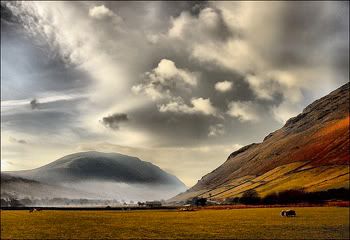1. Maximize your Depth of Field
While there may be times that you want to get a little more creative and experiment with narrow depth of fields - the normal approach is to ensure that as much of your scene is in focus as possible. The simplest way to do this is to choose a small Aperture setting (a large number) as the smaller your aperture the greater the depth of field in your shots.
Do keep in mind that smaller apertures mean less light is hitting your image sensor at any point in time so they will mean you need to compensate either by increasing your ISO or lengthening your shutter speed (or both). Of course there are times when you can get some great results with a very shallow DOF. Know each well enough to know their effect and when best to use one or the other.
2. Look for a Focal Point
All shots need some sort of focal point to them. Focal points can take many forms and could range from a prop, object, person or part of a person, an animal, building or structure, a striking tree, a boulder or rock formation, a silhouette etc. Think not only about what the focal point is but where you place it. The rule of thirds might be useful here. Also, helps to think about what it means (JT's note).
3. Think Foregrounds
One element that can set apart your shots is to think carefully about the foreground of your shots and by placing points of interest in them. When you do this you give those viewing the shot a way into the image as well as creating a sense of depth in your shot.
4. Consider the Sky
Another element to consider is the sky. If you have a bland, boring sky - don’t let it dominate your shot and place the horizon in the upper third of your shot (however you’ll want to make sure your foreground is interesting). However if the sky is filled with drama and interesting cloud formations and colors - let it shine by placing the horizon lower. Consider enhancing skies either in post production or with the use of filters (for example a polarizing filter can add color and contrast).

5. Lines
One of the questions to ask yourself as you compose a shot is ‘how am I leading the eye of those viewing this shot’? There are a number of ways of doing this (foregrounds is one) but one of the best ways into a shot is to provide viewers with lines that lead them into an image. Lines give an image depth, scale and can be a point of interest in and of themselves by creating patterns in your shot.

6. Capture Movement
Conveying movement in an image will add drama, mood and create a point of interest. Capturing movement generally means you need to look at a longer shutter speed (sometimes quite a few seconds). Of course this means more light hitting your sensor which will mean you need to either go for a small Aperture, use some sort of a filter or even shoot at the start or end of the day when there is less light.
7. Work with the Weather
Many beginners see a sunny day and think that it’s the best time to go out with their camera - however an overcast day that is threatening to rain might present you with a much better opportunity to create an image with real mood and ominous overtones. Look for storms, wind, mist, dramatic clouds, sun shining through dark skies, rainbows, sunsets and sunrises etc and work with these variations in the weather rather than just waiting for the next sunny blue sky day.
8. Work the Golden Hours
I chatted with one photographer recently who told me that he never shoots during the day - his only shooting times are around dawn and dusk - because that’s when the light is best and everything comes alive.

9. Think about Horizons
It’s an old tip but a good one - always consider the horizon on two fronts.
- Is it straight? - while you can always straighten images later in post production it’s easier if you get it right in camera.
- Where is it compositionally? - a compositionally natural spot for a horizon is on one of the thirds lines in an image (either the top third or the bottom one) rather than completely in the middle. Of course rules are meant to be broken - but I find that unless it’s a very striking image that the rule of thirds usually works here.
10. Change your Point of View
Take a little more time with your shots - particularly in finding a more interesting point of view to shoot from. Explore the environment and experiment with different view points and you could find something truly unique.















That's a great list!
ReplyDeleteOne book I'd recommend to anyone interested in the subject:
The Visual Story
By Bruce Block
Brisk information...
ReplyDeleteThanks a lot!